Everyone can benefit from art journaling. Dubious? For a moment, put aside the reasons you don’t keep an art journal and instead focus on these 10 compelling reasons to art journal.
1) An art journal can be a great outlet for your feelings.
A joint study conducted by the University of Auckland and the University of Nottingham found that expressive writing can help wounds heal faster. Your journal won’t judge you. You can write that you hate puppies and hear no gasp. Also, unlike a therapist, it is present 24 hours a day to listen to you. You can vomit your emotions out on the pages of your journal. Tell it things you wouldn’t dare tell anyone else with no repercussions.
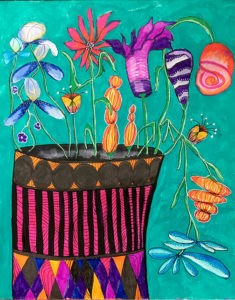 As an added bonus, in an art journal if you express negative thoughts, you can leave your feelings right there on the page if you like, or you can cover them up with art. No one will be the wiser; however, you will likely benefit from the practice since journaling accelerates the process of healing. The flower journal page to the right is an example of me covering up my negative thoughts with art. Check out the step-by-step process on the Quieting Your Inner Critic post — I show you the negative thoughts right through to the art.
As an added bonus, in an art journal if you express negative thoughts, you can leave your feelings right there on the page if you like, or you can cover them up with art. No one will be the wiser; however, you will likely benefit from the practice since journaling accelerates the process of healing. The flower journal page to the right is an example of me covering up my negative thoughts with art. Check out the step-by-step process on the Quieting Your Inner Critic post — I show you the negative thoughts right through to the art.
Conversely, your art journal can also be a lovely place to collect your positive thoughts and feels. A nice sunny page will be staring up at you when you flip through your journal reminding you of when you felt “good as hell” as Lizzo would say.
Journaling Technique
 If you’re not sure how to include your feelings in your art journal, try this technique. Open your journal and grab a pencil. Start to write in a loopy cursive how you are feeling today. Continue your cursive writing from word to word, and even from line to line, without picking up your pencil or including any spaces. Your writing will be illegible, your feelings out, and your page started with a cool graphic element.
If you’re not sure how to include your feelings in your art journal, try this technique. Open your journal and grab a pencil. Start to write in a loopy cursive how you are feeling today. Continue your cursive writing from word to word, and even from line to line, without picking up your pencil or including any spaces. Your writing will be illegible, your feelings out, and your page started with a cool graphic element.
2) An art journal is the ideal place to practice creativity.
You fall into one of two categories: you think of yourself as a creative person or you think of yourself as a person who lacks creativity. Either way, an art journal can help you better yourself.
The best way to continue to (or begin to) develop creativity is through practice. Innovation is not some divine gift; it’s actually just applying knowledge in new and exciting ways. It requires changing up one’s normal routine, stepping outside of typical comfort zones, and paying attention to the present moment.
Therefore, an art journal is the perfect place to practice creativity. Creativity can be acquired and honed at any age or experience level. By merely showing up and practicing, you will become more creative. So, open your art journal and just begin.
Journaling Technique
Here’s a warm up to get your creative juices flowing. Open your journal and grab two colored pencils or markers. Hold one in your left hand and one in your right hand. Draw in a squiggly pattern with both hands at the same time. Allow the lines to overlap, intersect, and become interesting. Continue until the squiggle has moved around the space enough for you to find some shapes in it. Either color it as an abstract, fill the spaces with patterns, or use your supplies to pull a shape out as a focal point on the page.
3) You can let go and play in an art journal without repercussion.
Fill in the blank: the best time of the day when you were in Elementary school was _____________. If you’re like me, you answered recess or art. Guess what? Your art journal is recess with art!
Lots of people are scared to put paint on a canvas because they don’t feel like it will be good enough. The beauty of an art journal is that you are creating only for yourself and if it sucks, so what? This releases the pressure of having to make “good art” and allows you to just play.
Journaling Technique
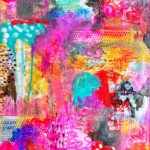 Smush some colors together and see what happens. Scribble and see if anything appears. Splatter and drip paint for no other reason than because it’s fun. You might like the result and you might not, but experimentation is valuable either way. As adults, we have fewer opportunities to play without abandon. Use your art journal and do as Elsa says, “Let it go!”
Smush some colors together and see what happens. Scribble and see if anything appears. Splatter and drip paint for no other reason than because it’s fun. You might like the result and you might not, but experimentation is valuable either way. As adults, we have fewer opportunities to play without abandon. Use your art journal and do as Elsa says, “Let it go!”
4) An art journal is the perfect place to explore art mediums.
Have you tried to paint on top of oil pastels? Tried to layer watercolors and acrylics? Used Brusho pigments? Activated Gelatos on a Gessoed vs. a non-Gessoed surface? An art journal is the perfect place to play with art mediums and try out different techniques. It’s also a great way to see how mediums do or don’t mix well.
Journaling Technique
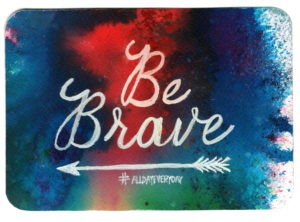 Get out two to four different art supplies you already have. They don’t have to be from an art store; it can be crayons, markers, and colored pencils. Draw a basic flower shape and use different combinations of art media on each petal. See which ones work and which ones don’t. Keep notes on the page or the facing page so you can refer back to it.
Get out two to four different art supplies you already have. They don’t have to be from an art store; it can be crayons, markers, and colored pencils. Draw a basic flower shape and use different combinations of art media on each petal. See which ones work and which ones don’t. Keep notes on the page or the facing page so you can refer back to it.
For more inspiration, check out this post on Brusho to see some experiments I did and what I learned from them.
5) You will learn new things.
You ARE creative. Seriously. And you can be a good artist if you want to be. Art is a skill. If you can learn to play an instrument or learn to read, you can learn to be halfway decent at art. And if you’re already halfway decent, you can be better. Learn to look at something and draw what you see, distinguish between light and shadows, or to make abstracts. You decide what you want to learn. If you aren’t sure, try lots of different things out in your art journal until you like something so much you want to try it again and again. Each time you see something you like and you try it out, you’re learning. It’s fun AND useful. #winninglife
Journaling Technique
Use one reference photo and recreate it four different ways. See what you learn. Here’s an example I did. I used a Picasso line drawing of Francoise Gilot and then I created these four different pages in my art journal using it as a reference. I don’t love the outcome of each experiment, but I love what I learned trying new things.

6) You can explore ideas for larger projects.
Did you know that Picasso produced 178 sketchbooks in his life time? He often used his sketchbooks to explore themes and make compositional studies until he found the right idea and subject for a larger painting on canvas. Check out this example from the Guggenheim of one of Picasso’s sketchbooks. Over and over he returned to the same themes—copies of Old Masters, and drawings of a woman in Turkish clothing, which may have been variations for his painting Jacqueline in Turkish Costume (1955), a portrait of his second wife, Jacqueline Roque.
The most famous artist sketchbooks are those of Leonardo da Vinci. His sketchbooks are filled with drawings, diagrams, and written notes of things he saw and ideas he came up with. The British library published several of da Vinci’s sketchbooks online. This sketchbook shows studies of 3 inventions and you can take a virtual flip right through it. Amazing.
Conceptually, an art journal and a sketchbook are the same thing. If you create something you really like, you can explore the ideas further. You might end up writing a book, inventing something new, or use your journal page as a catalyst for a large series or body of work.
Journaling Technique
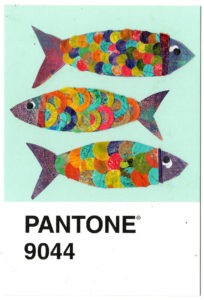 After you have 10 or more art journal pages done, look through and find the one you like the best. Could you turn that into a series of 10 pieces with a unifying factor, yet elements of differentiation in each piece. Or, could you make it a much larger piece? This fish I created on a small postcard as part of my 100 Day Project last year is an example of a piece I want to recreate on a large scale.
After you have 10 or more art journal pages done, look through and find the one you like the best. Could you turn that into a series of 10 pieces with a unifying factor, yet elements of differentiation in each piece. Or, could you make it a much larger piece? This fish I created on a small postcard as part of my 100 Day Project last year is an example of a piece I want to recreate on a large scale.
7) An art journal is a great place to deepen your spiritual practice.
Many people keep Bible Art Journals. They are gorgeous. Art journal in or about your Bible or book of worship to explore the meaning of a passage. Essentially, it’s the same concept as a thematic art journal with your religion as a theme. Just as discussing a religious passage helps you have a deeper understanding, creating art about a passage’s meaning will help you have a deeper understanding and connection to it.
Journaling Technique
 If you have a book for worship, take a passage or quote and create a page about it. Whatever your spiritual beliefs, think about a value you hold dear. Make an art journal page to express it in a beautiful way.
If you have a book for worship, take a passage or quote and create a page about it. Whatever your spiritual beliefs, think about a value you hold dear. Make an art journal page to express it in a beautiful way.
In my art journal round robin group, one person established a Bible verse theme. Although I am not religious, I was able to find a passage that aligns with my beliefs and create a really cool spread in her journal.
8) It’s a cliche for a reason: practice makes perfect.
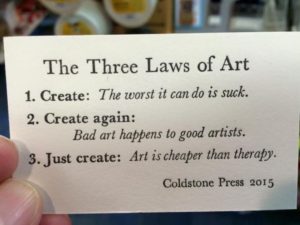 If you want to be a good artist, you have to create a lot of art. This might seem obvious, but the more you practice, the better you get at it. An actor doesn’t go on stage without rehearsing. Without practice, an athlete doesn’t perform at his/her peak. In the same regard, practicing regularly in your journal will help you improve your technique, efficiency, and confidence. You’ll be a better artist the more you play in your art journal.
If you want to be a good artist, you have to create a lot of art. This might seem obvious, but the more you practice, the better you get at it. An actor doesn’t go on stage without rehearsing. Without practice, an athlete doesn’t perform at his/her peak. In the same regard, practicing regularly in your journal will help you improve your technique, efficiency, and confidence. You’ll be a better artist the more you play in your art journal.
It’s also important to remember that most people aren’t great at something when they first start. So, don’t compare your art to other people’s. Remember that you are in a different place in your journey.
Journaling Technique
Journal everyday or at least schedule it regularly for maximum benefit.
9) Work your way through a creative block.
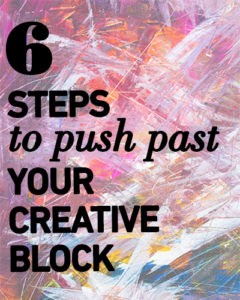 When facing a creative block, one way to overcome it is to open your journal without any expectation and do something — anything, really — but something. Take out your favorite art supply and make marks for one minute. Allow yourself to stop after that minute if you want to. 99% of the time, you’ll find yourself continuing past the one minute mark. Before you know it, your creative instincts will take over and you’ll be back in the game.
When facing a creative block, one way to overcome it is to open your journal without any expectation and do something — anything, really — but something. Take out your favorite art supply and make marks for one minute. Allow yourself to stop after that minute if you want to. 99% of the time, you’ll find yourself continuing past the one minute mark. Before you know it, your creative instincts will take over and you’ll be back in the game.
Journaling Technique
Hop over and read my previous post on how to overcome creative blocks for some more solid tips and techniques.
10) Become less stressed and/or anxious.
Ready for a scientific truth bomb? Art journaling can help you physically reduce your stress and anxiety. “The amygdala, an almond-shaped collection of neurons located on each side of the lobe, registers emotional information and helps us identify our surroundings to determine whether it is dangerous or not,” explains Dr. Francisco Cruz, lead psychiatrist at Ketamine Health Centers, Florida. Once journaling becomes a daily habit, the amygdala begins to register journaling as a safe zone for personal growth, healing and reflection, adds Cruz.
Journaling Technique
Journal about something that stressing you out or gives you anxiety. Today, for example, I’m planning on journaling about the Corona Virus. Putting it down on paper helps me record my thoughts, feelings, history, and think my way through it. I’ll update this post with a pic of it when I finish.
Conclusion
Clearly, keeping an art journal is beneficial. The only way to benefit, though, is to use it and use it regularly. To get the most out of your practice, I challenge you to carry your sketchbook around with you wherever you go for a month. When you have a minute to spare, don’t open your phone and scroll mindlessly; look around you and sketch something you find interesting in your journal.
So let me know in the comments: Do you already journal or art journal? How does it benefit you? And if you don’t, how could you personally benefit from art journaling?
Sign up for the Artful Pursuits newsletter to receive monthly tips and more samples of art journal pages and techniques:


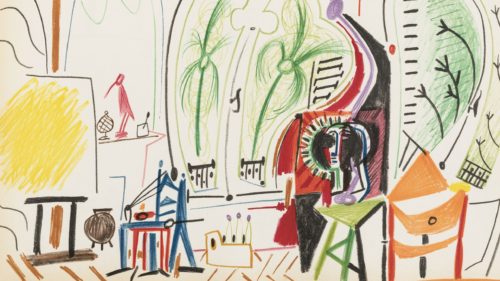


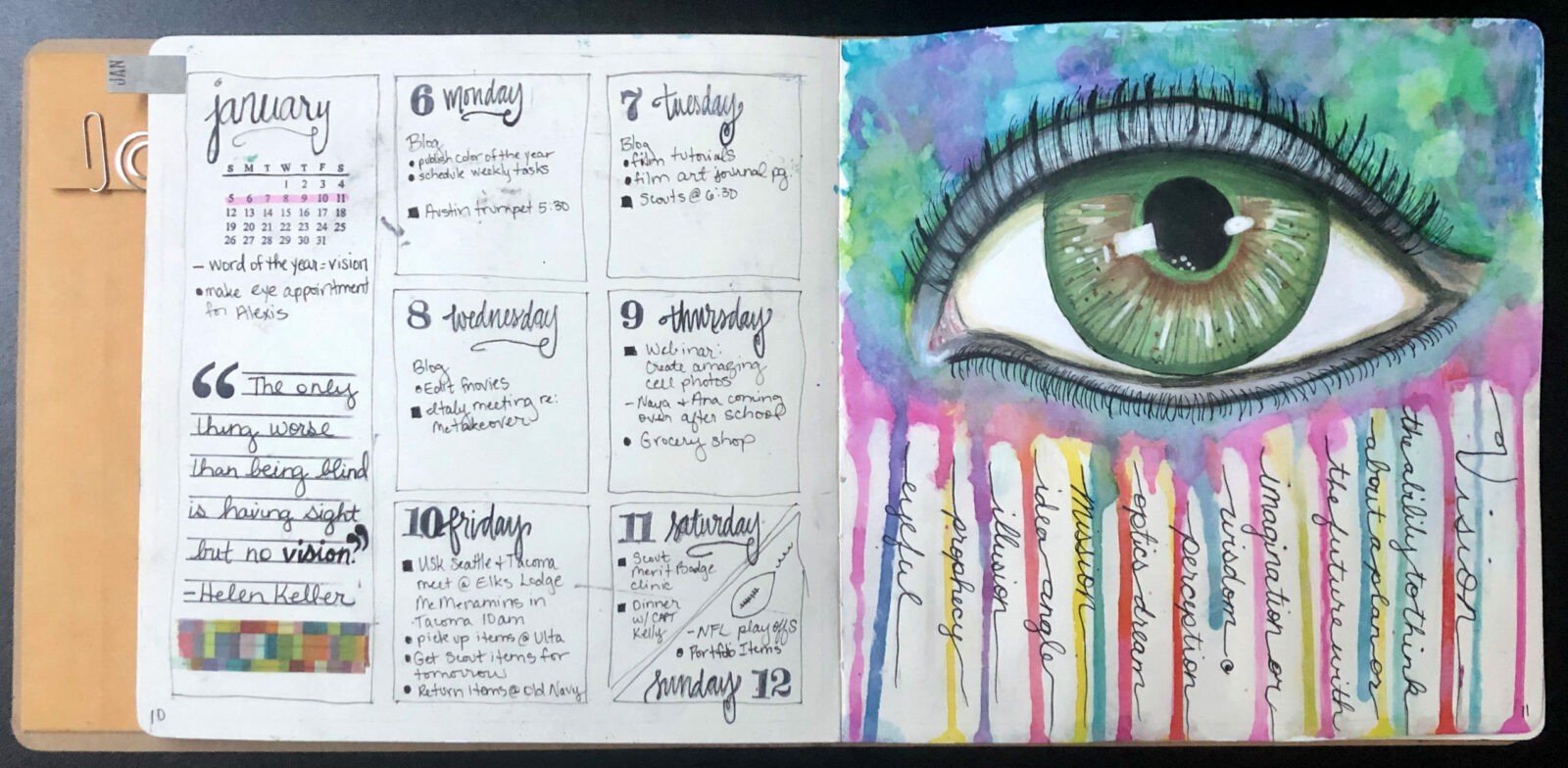



12 Comments. Leave new
What a wonderfully complete post! I have art journaled for years, and I can’t imagine life without it. I consider myself to be a writer and artist, and it’s been interesting to note over the years how important my art journaling is to my writing process. When I don’t art journal, I struggle to write. It’s as if the process of creating in my art journal unblocks something an allows more creativity to flow. Thanks for sharing the benefits as well as techniques to try!
Thanks, Kaecey. I used to consider myself a writer. Only since I started blogging regularly has that part of me been reawakened. I haven’t ever been able to consistently journal in a traditional diary sense, but I can art journal regularly and it tells me a story almost as much as traditional journaling sometimes.
I like the flower petal idea! I really enjoy doing “zentangle” inspired art. It is very soothing!
Yes. Zentangling is another great technique. I just zentangled some hair recently and it was so meditative.
This is such good info, I can get hung-up on not knowing where to start, but should just start!
When I don’t know how to start, I’ll do 3 things: collage the background, add some blocks of color, and use a stencil to add some texture. Then I look at it carefully and see if a subject matter or focal point can be found in the abstract background. Once I see something, the momentum takes off.
This is really creative! I never thought to start an Art Journal because I don’t see myself as artistic, but you changed my mind!
That’s awesome. I think you’ll really enjoy it. Let me know if you have any questions as you get going 🙂
I have a journal coming on Amazon. It’s something I’ve always wanted to do but now I’m going to actually DO it! Thank you for all this great information. It really makes me excited to start my art journal 🙂
That makes me so happy, Susan! Enjoy the process and let me know if you have any questions 🙂
I’m more of a writer but spent much time as a child with my art supplies. I can see how many of your ideas could tie in with my writing. I’m going to try some of your ideas. Maybe I’ll start with a quote I like and create what it makes me feel and see. Thank you. I found you on the 10K blog challenge.
That’s a great idea. Do you participate in the 100 Day Project by chance? A lot of writers, visual artists, and others find ways to make the challenge fit their genre of choice.